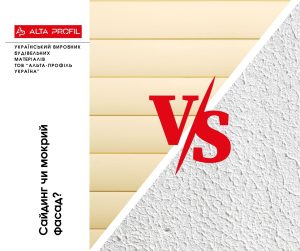
Vinyl Siding vs. “Wet” Facade: Comparison and Advantages
1. Ease and Speed of Installation
Vinyl siding:
- Lightweight and easy to install, does not require special skills or expensive tools.
- Can be installed at any time of the year, even at temperatures as low as -5°C.
Wet facade:
- Installation is more complex and includes the application of adhesives, plaster, and paint.
- Requires strict adherence to the process, especially in high humidity or low temperatures.
2. Durability and Resistance to External Factors
Vinyl siding:
- UV-resistant, does not fade in the sun.
- Not affected by moisture, does not corrode, rot, or develop mold.
- Easily withstands temperature fluctuations.
Wet facade:
- Can be damaged by moisture if installation technology is violated.
- The plaster layer may crack due to temperature changes, especially if materials are chosen incorrectly.
- Requires regular maintenance and repairs.
3. Thermal Insulation
Vinyl siding:
- Often installed with insulation (mineral wool, polystyrene), which improves the building’s energy efficiency.
- The absence of wet processes eliminates the risk of condensation under the cladding if improperly installed.
Wet facade:
- Provides high thermal insulation if quality materials are used and technology is followed.
- Risk of thermal bridging due to incorrect installation of insulation.
4. Maintenance and Care
Vinyl siding:
- Practically maintenance-free, easy to clean with water.
- No need for painting or additional treatments.
Wet facade:
- Requires regular care and periodic repairs (painting, patching).
- Mold or mildew may appear due to humidity.
5. Aesthetics and Design Flexibility
Vinyl siding:
- Wide range of colors, textures, and styles (wood, stone imitation, etc.).
- Allows for affordable exterior upgrades.
Wet facade:
- Offers more options for customized design through colors and textures.
- However, updating the appearance requires more time and money.
6. Cost
Vinyl siding:
- Often more affordable due to simpler installation and no wet processes.
- Lower long-term maintenance and repair costs.
- No need to pre-level walls — can be installed on almost any surface.
- Installation can be done independently without professional tools or skills.
Wet facade:
- Requires higher upfront costs, especially with quality insulation materials.
- Higher labor costs.
- Potential extra expenses for repainting and repairs.
- Final cost may exceed initial estimates.
‼ Conclusion
Vinyl siding is an optimal choice for those who seek a quick, affordable, and long-lasting facade solution with minimal maintenance. It’s suitable for most climates and requires no special upkeep. Any type of insulation — such as polystyrene or mineral wool — can be used behind the siding.
Wet facade is ideal for those willing to invest more during installation and looking for an aesthetically appealing solution with good thermal insulation. However, it requires regular maintenance and precise adherence to installation technology. It’s also important to consider wall types, construction layers, and temperature conditions during installation.
Ultimately, the choice between these two systems depends on your budget, building conditions, climate, and personal preferences.
For consultation on vinyl siding, material calculations, and pricing for your project — call:
067-319-69-33, 067-319-60-59



